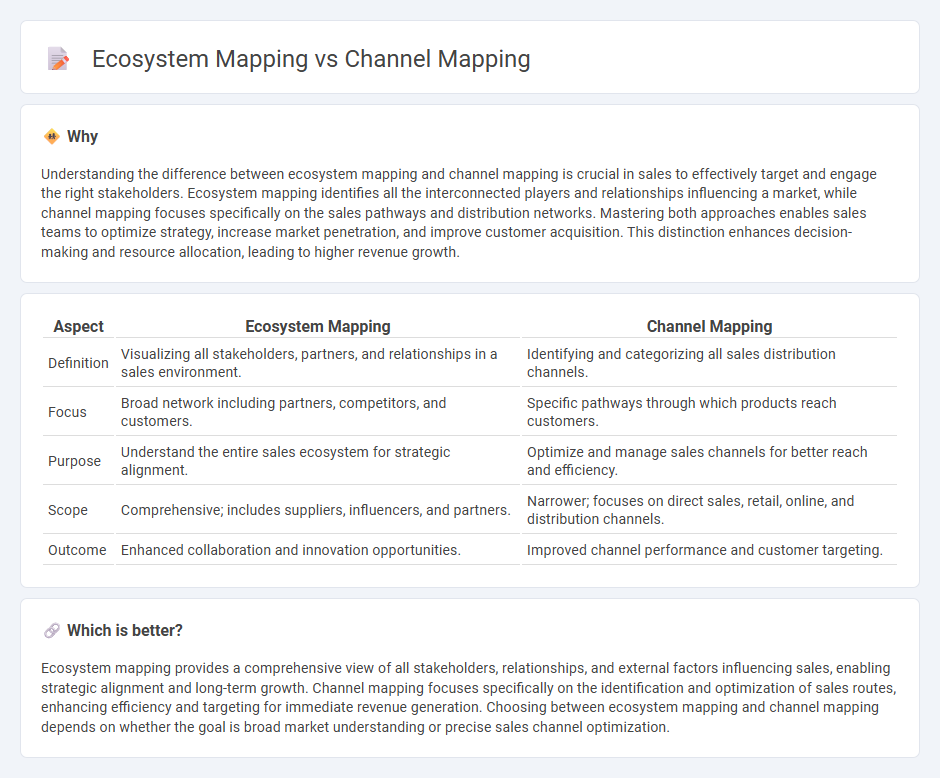
Sales ecosystem mapping identifies all stakeholders, resources, and external factors influencing the entire sales process to optimize collaboration and strategy. Channel mapping focuses specifically on the distribution paths, partners, and touchpoints that deliver products or services to customers, enhancing channel performance and reach. Explore deeper insights into how ecosystem and channel mapping can transform your sales strategy.
Why it is important
Understanding the difference between ecosystem mapping and channel mapping is crucial in sales to effectively target and engage the right stakeholders. Ecosystem mapping identifies all the interconnected players and relationships influencing a market, while channel mapping focuses specifically on the sales pathways and distribution networks. Mastering both approaches enables sales teams to optimize strategy, increase market penetration, and improve customer acquisition. This distinction enhances decision-making and resource allocation, leading to higher revenue growth.
Comparison Table
| Aspect | Ecosystem Mapping | Channel Mapping |
|---|---|---|
| Definition | Visualizing all stakeholders, partners, and relationships in a sales environment. | Identifying and categorizing all sales distribution channels. |
| Focus | Broad network including partners, competitors, and customers. | Specific pathways through which products reach customers. |
| Purpose | Understand the entire sales ecosystem for strategic alignment. | Optimize and manage sales channels for better reach and efficiency. |
| Scope | Comprehensive; includes suppliers, influencers, and partners. | Narrower; focuses on direct sales, retail, online, and distribution channels. |
| Outcome | Enhanced collaboration and innovation opportunities. | Improved channel performance and customer targeting. |
Which is better?
Ecosystem mapping provides a comprehensive view of all stakeholders, relationships, and external factors influencing sales, enabling strategic alignment and long-term growth. Channel mapping focuses specifically on the identification and optimization of sales routes, enhancing efficiency and targeting for immediate revenue generation. Choosing between ecosystem mapping and channel mapping depends on whether the goal is broad market understanding or precise sales channel optimization.
Connection
Ecosystem mapping identifies the network of stakeholders, including partners, customers, and competitors, influencing a business, while channel mapping details the specific pathways through which sales reach end customers. Together, they provide a comprehensive view of the sales distribution landscape, enabling businesses to optimize channel strategies, enhance partner collaborations, and maximize market penetration. Integrating ecosystem and channel mapping drives targeted sales growth by aligning resources with high-impact channels within the broader market environment.
Key Terms
**Channel Mapping:**
Channel mapping identifies and organizes the specific pathways through which products or services reach customers, highlighting direct, indirect, and digital routes crucial for optimizing sales and distribution strategies. It emphasizes the roles of intermediaries such as wholesalers, retailers, and online platforms to ensure efficient market coverage and customer engagement. Discover more about how precise channel mapping can enhance your market penetration and customer experience.
Distribution Channels
Channel mapping identifies specific pathways through which products or services flow from producers to consumers, emphasizing the selection and management of distribution channels like wholesalers, retailers, or direct sales. Ecosystem mapping encompasses a broader network, illustrating relationships among all stakeholders including suppliers, competitors, partners, and regulatory bodies, providing a comprehensive overview of market dynamics. Explore how mastering these mapping techniques can optimize your distribution strategy and enhance market reach.
Partner Networks
Channel mapping identifies specific pathways through which products or services reach the end customer, emphasizing sales routes and distribution strategies within partner networks. Ecosystem mapping takes a broader view, detailing the relationships and interactions among various stakeholders, including partners, suppliers, and customers, to highlight value creation and collaboration opportunities. Explore how these mapping strategies can optimize your partner networks for enhanced growth and innovation.
Source and External Links
Channel Mapping Guide - This guide explains how to create a channel map in Synapse for TDT headstages and probes, detailing how electrode sites on a probe are mapped to amplifier channels and how to trace signal routing through adapters and headstages for proper channel assignment.
Channel mapping: Full guide for hotels - Channel mapping in hospitality involves syncing room types and rates between a hotel's platform and third-party distribution channels to ensure accurate availability and pricing, using a step-by-step process including adding channels, mapping rates, and enabling multi-mapping for different rate scenarios.
Channel mapping - In telecommunications, channel mapping refers to the assignment of logical channels to transport and physical channels, specifying how control and traffic data are carried across uplink and downlink paths in wireless communication systems.
 dowidth.com
dowidth.com